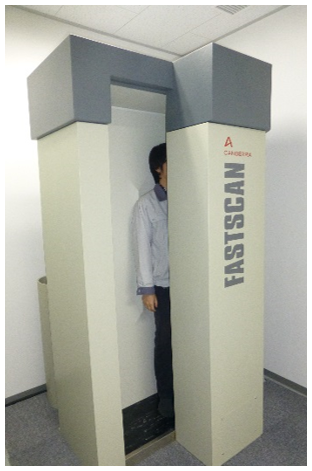Assessment of Exposure Doses and Decontamination
(2013)
QHow can we evaluate radioactive material taken inside our body?
AWe can evaluate how much radioactive material has taken into body by Whole Body Counter (WBC). We had been measured radioactive iodine just after the accident and radioactive cesium thereafter.

Fig.1 Whole body counter
By measuring gamma rays emitted by radioactive material, we can evaluate the amount of radioactive material taken inside the body.
Most cesium atays within the top 5 cm of the ground.
| Age | No. of peple and effective dose range | |||
|---|---|---|---|---|
| < 1 mSv | 1~1.4 mSv | 1.5~2.4 mSv | 2.5~3.4 mSv | |
| < 8 | 2,373(99.3) | 6(0.3) | 8(0.3) | 2(0.1) |
| 8~12 | 2,840(99.8) | 5(0.2) | 0(0.0) | 0(0.0) |
| 13~17 | 1,565(100) | 0(0.0) | 0(0.0) | 0(0.0) |
| > 17 | 3,127(100) | 1(0.0) | 0(0.0) | 0(0.0) |
| Total | 9,905(99.8) | 12(0.1) | 8(0.0) | 2(0.0) |
JAEA and other institutes have been continuously measuring rasdioactive cesium by WBC for large number of residents in Fukushima. This table shows the results of effctive dose ranges of residents living in 11 cities in Fukushima (estimated based on the results of WBC measurements taken between july 2011 to February 2012).
- Reduction of air dose rates at flat locations can be explained by the shielding effect of the soil.
- So far, the results indicating significant internal exposure have not been reported.
Related articles
Reference
- Momose, T., Takada, C., Nakagawa, T., Kanai, K., Kurihara, O., Tsujimura, N., Ohi, Y., Murayama, T., Suzuki, T., Uezu, Y. and Furuta, S. (2012): Whole-body counting of Fukushima residents after the TEPCO Fukushima Daiichi Nuclear Power Station Accident, Proceedings of the 1st NIRS Symposium on Reconstruction of Early Internal Dose in the TEPCO Fukushima Daiichi Nuclear Power Station Accident, NIRS-M-252, National Institute of Radiological Sciences, , 67-82.
